Safest Herbs to Smoke

At Sacred Plant Co., we field a steady stream of questions about safe herbs to smoke. The truth is nuanced. While certain botanicals carry centuries of traditional use and acceptable modern safety signals, all combustion produces harmful byproducts. No smoked substance is risk-free. That reality doesn't erase the historical or ritualistic value of herbal smoke, but it does demand honest, evidence-forward guidance.
This guide ranks common smokable herbs by their documented benefits and known risks, flags who should never inhale combustion smoke, and offers practical harm-reduction strategies. Whether you're evaluating mullein for respiratory support or exploring ceremonial blends, we'll show you what the research actually says and where the gaps remain.
Looking for traditional uses and herbal smoking blends? Before diving into the safety analysis, explore our complete guide to the best herbs for smoking to understand the ceremonial and traditional context behind these botanicals.
What Research Shows About Herbal Smoke
Combustion chemistry doesn't change when you switch from tobacco to mullein. Any organic material burned at high temperature releases carbon monoxide, particulate matter (PM2.5), polycyclic aromatic hydrocarbons (PAHs), and volatile organic compounds.1 A 2020 review in Toxicology Reports confirmed that herbal cigarettes produce tar and carcinogens at levels comparable to conventional tobacco, though nicotine is absent.2
Key combustion byproducts in all herbal smoke:
- Carbon monoxide – binds hemoglobin, reducing oxygen delivery to tissues.
- PM2.5 – ultra-fine particles that penetrate deep into lung tissue and trigger inflammation.
- PAHs – genotoxic compounds formed when plant material burns incompletely.
- Aldehydes (formaldehyde, acrolein) – irritants linked to chronic bronchitis and oxidative stress.
Studies using gas chromatography-mass spectrometry show that mint, rose petal, and corn silk cigarettes all generated measurable PAH profiles.3 The absence of nicotine does not mean the absence of harm.
However, traditional herbalists and modern ethnobotanists point to potential respiratory benefits from specific plants when used in moderation and via lower-temperature methods. Mullein, for instance, contains saponins and mucilage that may coat irritated airways, while damiana has been used ceremonially for relaxation. The question is whether those benefits survive combustion and outweigh the toxic load.
Herb-by-Herb Benefits vs. Risks
We've synthesized peer-reviewed literature, toxicology databases, and traditional-use monographs to assess six commonly smoked herbs. Each entry includes documented actions, known risks, a safety tier, and direct access to our third-party tested products.
Mullein (Verbascum thapsus)
Traditional use: Respiratory demulcent; smoked or steeped for cough, bronchitis, and lung congestion.4
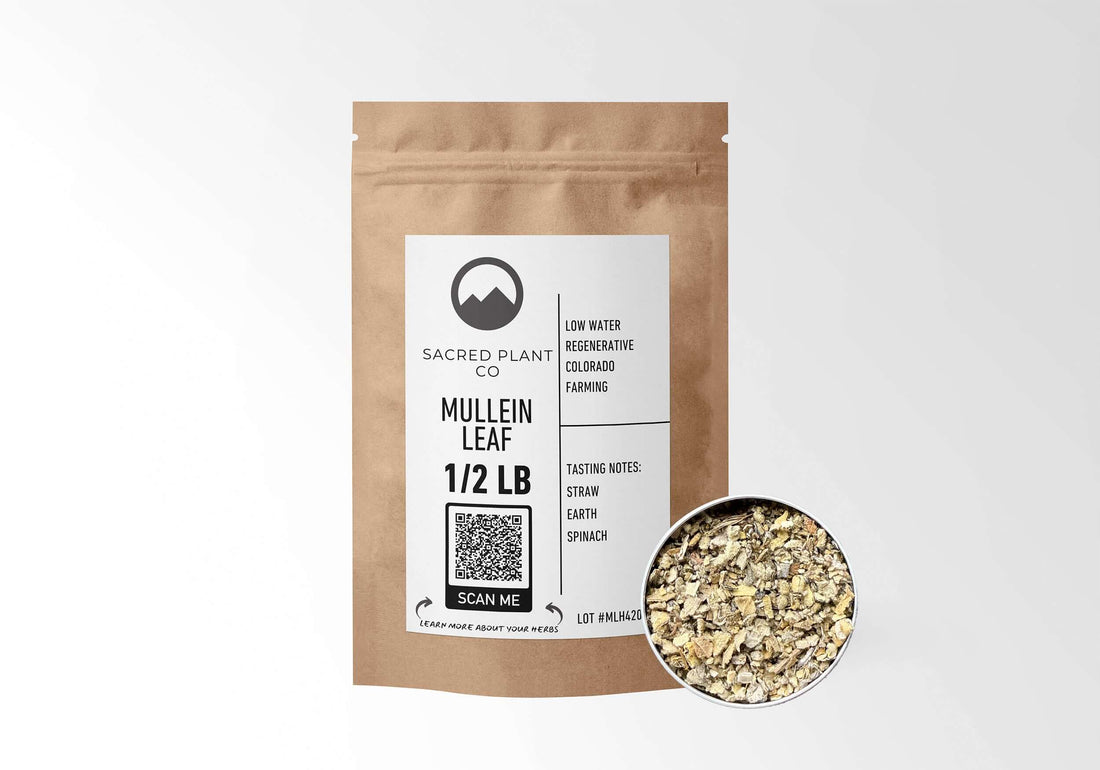
Traditional role: Respiratory support herb and base material
Mullein stands as the foundation of most herbal smoking blends. European and North American herbalists have used mullein leaf for respiratory complaints for centuries, and its role in smoking blends capitalizes on this traditional association. The large, soft leaves produce a light, smooth smoke with minimal harshness.
Flavor profile: Mild, slightly earthy, neutral base that doesn't overpower other herbs.
Shop Mullein Leaf →Active constituents: Saponins, mucilage, flavonoids (verbascoside), iridoid glycosides.
Proposed benefits: Mucilage may soothe inflamed mucous membranes; saponins exhibit mild expectorant action in vitro.5 Some herbalists report that mullein smoke feels "smooth" compared to other dried leaves.
Why it works: Mullein's low resin content and high mucilage create a gentle smoking experience. The leaf structure burns evenly at moderate temperatures. Traditional herbalists valued mullein for lung health, though smoking any material involves inhaling combustion byproducts.
Risks: Combustion still produces PAHs and CO. No clinical trials validate smoking mullein as therapeutic. One case series noted contact dermatitis from fresh mullein leaf, though inhalation allergy is rare.6
Preparation: Remove thick stems and central veins. Crumble dried leaves to a fluffy, medium consistency. Mix as 40-60% of your base blend.
Safety tier: Moderate. Better tolerated than many alternatives, but combustion risks apply. Our bulk mullein leaf is third-party tested and priced from $12.07, ideal for tea infusions — a safer method than smoking.
Damiana (Turnera diffusa)
Traditional use: Central American aphrodisiac and mood enhancer; smoked in ceremonial contexts.
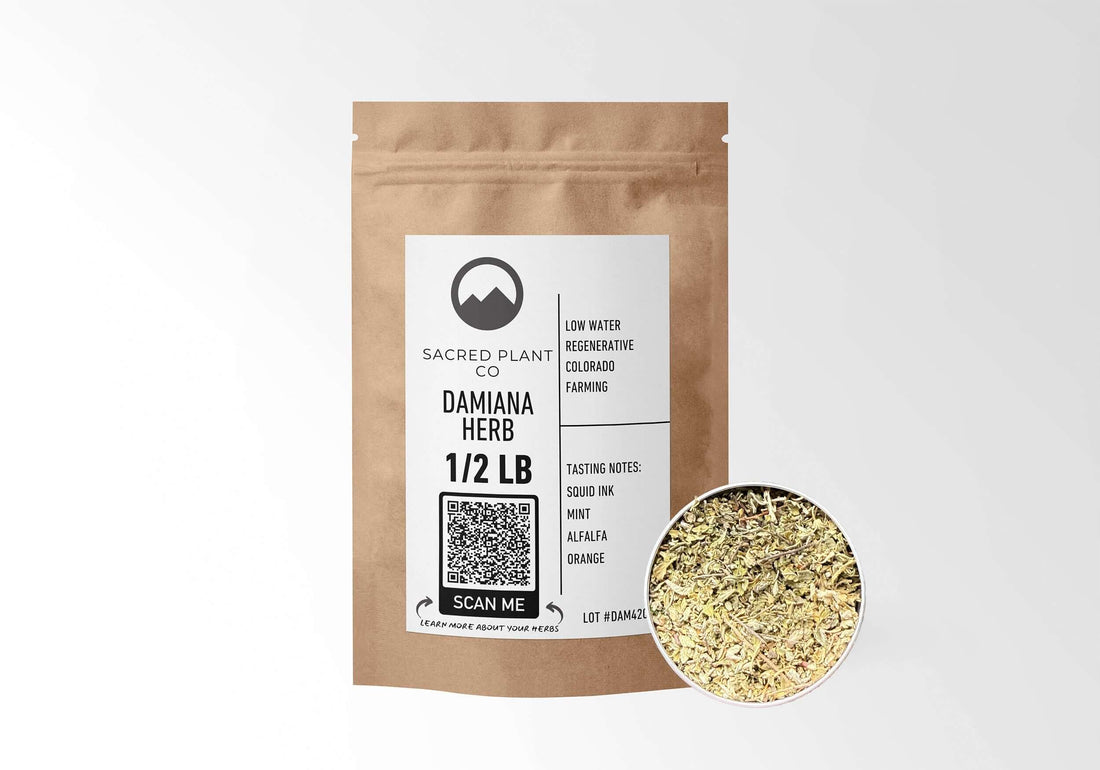
Traditional role: Mood elevation and relaxation herb
Indigenous communities in Mexico and Central America have used damiana for centuries, both as a tea and smoking herb. The Maya and Aztec peoples incorporated it into ceremonies and traditional medicine. Damiana gained attention in the 1970s as researchers documented its traditional uses, particularly for mood support and as a gentle nervine.
Flavor profile: Slightly bitter, aromatic, with warm herbal notes and mild sweetness.
Shop Damiana →Active constituents: Apigenin, arbutin, tannins, essential oils (thymol, cineole).
Proposed benefits: Mild anxiolytic and mood-lifting effects observed in rodent models; no human smoking trials.7
Why it works: Damiana's essential oils and flavonoids may contribute to relaxation effects. Traditional use emphasizes ceremonial and occasional consumption rather than daily smoking.
Risks: High tannin content may increase irritation when combusted. Arbutin metabolizes to hydroquinone, a compound flagged by the European Chemicals Agency for potential carcinogenicity under certain conditions.8
Preparation: Use small leaves whole; crush larger leaves lightly. Works well in 10-20% ratio combined with mullein or raspberry leaf base.
Safety tier: Moderate-low. Traditional use is well-documented, but combustion of high-tannin leaves warrants caution. Our bulk damiana ($28.99) is better suited for tinctures or low-temperature infusions.
Raspberry Leaf (Rubus idaeus)
Traditional use: Women's tonic (uterine support); occasionally smoked in herbal blends for mild flavor.
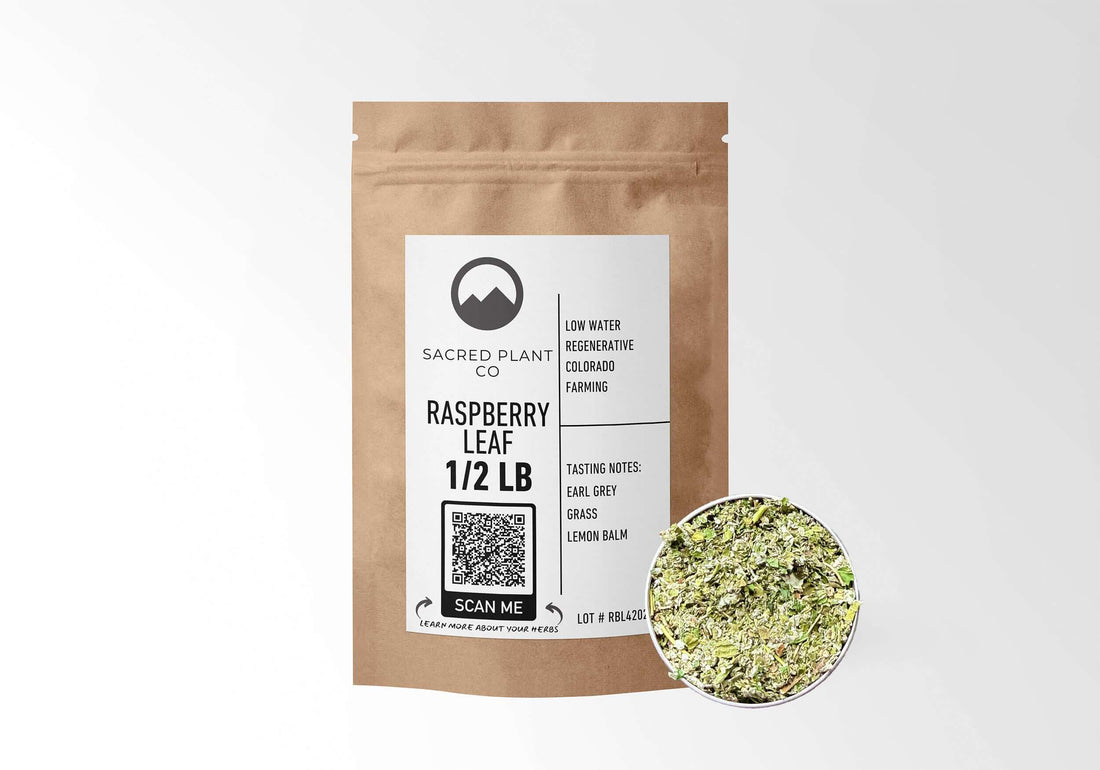
Traditional role: Gentle base herb with mild, pleasant flavor
Raspberry leaf is better known as a pregnancy tea than a smoking herb, but its mild flavor and smooth burn make it an occasional addition to herbal blends. European herbalists used it primarily for women's health, and its inclusion in smoking mixes is relatively modern. The leaf provides a neutral base without overpowering aromatic herbs.
Flavor profile: Light, slightly fruity, very mild with no bitterness.
Shop Raspberry Leaf →Active constituents: Fragarine (uterine relaxant), ellagic acid, flavonoids.
Proposed benefits: Minimal respiratory claims; used more for taste and gentle smoke.
Risks: Fragarine's uterotonic effects mean pregnant individuals should avoid all routes of administration, including smoke. Combustion byproducts remain standard.9
Preparation: Crumble dried leaves to medium-fine consistency. Use as 20-40% of base blend for mild, neutral flavor.
Safety tier: Low-moderate. Avoid if pregnant; otherwise comparable risk to mullein. Our regeneratively grown raspberry leaf ($10.98) shines as a pregnancy tea in the third trimester when used appropriately — never smoked.
Lobelia (Lobelia inflata)
Traditional use: Smoking cessation aid; respiratory stimulant in Eclectic herbal medicine.
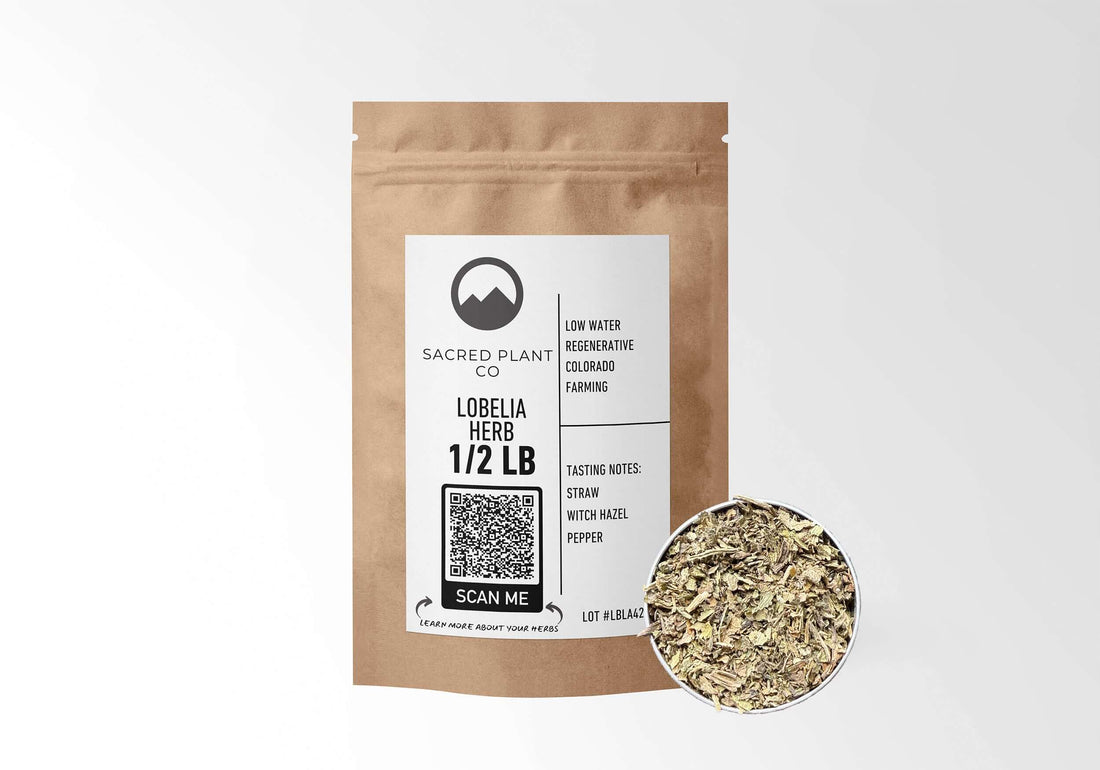
⚠️ CAUTION: Narrow therapeutic window – Professional guidance required
Lobelia carries a complex history in American herbalism. Eclectic physicians of the 19th century used it as a respiratory stimulant and emetic, earning it the nickname "puke weed." Its use in smoking blends is controversial due to lobeline's powerful effects on nicotinic receptors. Traditional dosing required precise measurement and professional supervision.
Safety note: Smoking concentrates alkaloids unpredictably. Overdose symptoms include nausea, dizziness, tremor, and respiratory depression.
View Lobelia →Active constituents: Lobeline (nicotinic receptor partial agonist).
Proposed benefits: Lobeline may reduce nicotine cravings by occupying acetylcholine receptors without full activation.10
Risks: Narrow therapeutic window. Overdose symptoms include nausea, dizziness, tremor, and respiratory depression. The FDA classifies lobelia as unsafe for internal use in supplements at high doses.11 Smoking concentrates alkaloids unpredictably.
Safety tier: Low. We do not recommend smoking lobelia without professional herbalist guidance. Our bulk lobelia ($13.56) is intended for low-dose tincture use only — consult a clinical herbalist before use.
Coltsfoot (Tussilago farfara)
Traditional use: Antitussive; smoked or steeped for chronic cough in European folk medicine.
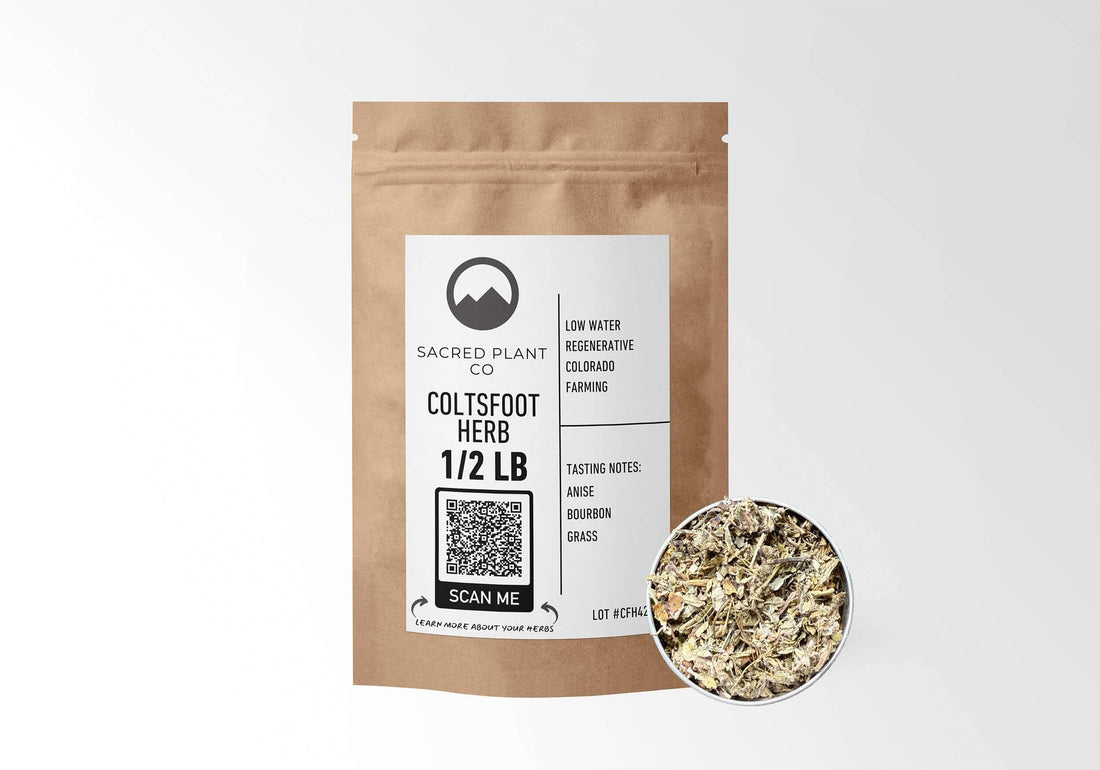
⛔ NOT RECOMMENDED: Contains hepatotoxic pyrrolizidine alkaloids
Coltsfoot was once a staple in European herbal medicine for respiratory complaints. Its Latin name Tussilago means "cough dispeller." However, modern toxicology research has identified pyrrolizidine alkaloids (PAs) in coltsfoot that cause liver damage and carry carcinogenic potential. Multiple countries now restrict or ban coltsfoot for internal use. Combustion does not eliminate these alkaloids.
Legal note: Banned or restricted for internal use in Germany, Canada, and other jurisdictions. Offered for historical reference only.
View Coltsfoot →Active constituents: Mucilage, pyrrolizidine alkaloids (PAs: senkirkine, senecionine).
Proposed benefits: Mucilage coats airways; some expectorant action reported anecdotally.
Risks: Pyrrolizidine alkaloids are hepatotoxic and potentially carcinogenic.12 Multiple countries restrict or ban coltsfoot for internal use. Combustion does not eliminate PAs and may concentrate them.
Safety tier: Avoid. Risk outweighs any traditional benefit. Our coltsfoot ($19.72) is offered for historical reference and external applications only — we do not recommend internal use or smoking. Always consult the COA and a qualified herbalist before purchase.
Blue Lotus (Nymphaea caerulea)
Traditional use: Ancient Egyptian entheogen; smoked or steeped for relaxation and mild euphoria.
Active constituents: Aporphine alkaloids (apomorphine precursors), nuciferine.
Proposed benefits: Dopaminergic activity in animal models; mild sedative-hypnotic effects reported anecdotally.13
Risks: Legal status varies (controlled in some jurisdictions). Apomorphine is a potent emetic and dopamine agonist; dosing via smoke is uncontrolled. Contamination and adulteration are common in commercial blue lotus.
Safety tier: Low-moderate. Legal and quality concerns limit safe use. We do not currently carry blue lotus due to variable legal status and quality-control challenges.
Who Should Never Smoke Herbs — and Why
Certain populations face disproportionate harm from any combustion smoke. We urge the following groups to avoid herbal cigarettes entirely and explore non-inhalation methods instead.
Pregnant and Breastfeeding Individuals
Carbon monoxide crosses the placenta and reduces fetal oxygen supply. Even nicotine-free herbal smoke increases maternal and fetal carboxyhemoglobin levels.14 Raspberry leaf, while safe as tea in late pregnancy, carries uterotonic alkaloids that should not be inhaled during gestation. Avoid all smoked herbs during pregnancy and lactation.
People with Asthma, COPD, or Chronic Bronchitis
Particulate matter and aldehydes trigger bronchospasm and worsen airway inflammation. A 2019 cohort study found that herbal cigarette smokers experienced a decline in FEV1 (forced expiratory volume) comparable to tobacco smokers over 12 months.15 If you have reactive airway disease, combustion smoke of any kind is contraindicated.
Individuals on CNS Depressants or Blood Thinners
Herbs like damiana and blue lotus may potentiate sedative medications (benzodiazepines, barbiturates). Coltsfoot's pyrrolizidine alkaloids interfere with hepatic drug metabolism. Always disclose herbal smoke use to your healthcare provider if you take prescription medications.
Children and Adolescents
Developing lungs are more vulnerable to PM2.5 and PAH exposure. Brain development continues into the mid-20s; introducing any psychoactive or sedative botanical via combustion carries unknown neurodevelopmental risks.
Harm-Reduction Tips if You Choose to Smoke Herbs
If ceremonial or personal practice leads you to herbal smoke despite the risks, these strategies reduce — but do not eliminate — harm.
1. Prioritize Quality and Testing
Source herbs from suppliers who provide certificates of analysis (COAs) for heavy metals, pesticides, and microbial contamination. Combusting moldy or pesticide-laden plant material multiplies toxic exposure. At Sacred Plant Co., every batch undergoes third-party testing before release.
2. Use Lower-Temperature Methods
Vaporization (≤200°C) releases volatile terpenes and some alkaloids without full combustion, reducing PAH and CO formation by up to 80 percent.16 Dedicated herbal vaporizers offer better control than open flame.
3. Limit Frequency and Volume
Occasional ceremonial use (once monthly or less) poses lower cumulative risk than daily smoking. If you're using herbal smoke as a tobacco substitute, address the underlying nicotine addiction with evidence-based cessation support rather than switching to herbal cigarettes.
4. Hydrate and Support Detoxification
Drink water before and after smoking to support mucociliary clearance. Antioxidant-rich foods (berries, leafy greens) may buffer oxidative stress from combustion byproducts, though diet cannot reverse lung damage.
5. Monitor Respiratory Symptoms
Persistent cough, wheezing, or shortness of breath are red flags. Discontinue use and consult a healthcare provider. Do not assume herbal smoke is benign because it "feels" smoother than tobacco.
Safer Alternatives to Smoking Herbs
You can access the traditional benefits of smokable herbs without combustion. These methods preserve active constituents while eliminating or drastically reducing toxic byproducts.
Hot Infusions (Teas)
Steeping mullein, damiana, or raspberry leaf in near-boiling water extracts mucilage, flavonoids, and volatile oils without generating PAHs or CO. Mullein tea is particularly effective for respiratory support; steep 1–2 teaspoons of dried leaf in 8 oz water for 10–15 minutes, strain well to remove irritating hairs.
Steam Inhalation
Inhaling steam from an herbal infusion delivers volatile compounds directly to the respiratory tract without combustion. Add mullein, eucalyptus, or thyme to a bowl of hot water, drape a towel over your head, and breathe deeply for 5–10 minutes. This method soothes congestion and delivers anti-inflammatory terpenes.
Tinctures and Glycerites
Alcohol or glycerin extracts concentrate alkaloids and resins for sublingual or internal dosing. Tinctures bypass the lungs entirely and allow precise dose control — especially important for potent herbs like lobelia.
Topical Applications
For herbs traditionally smoked for mood or relaxation (damiana, blue lotus), consider infused oils or salves. Transdermal absorption is slower but avoids first-pass metabolism and lung exposure.
Why Each Step Matters
Testing: Heavy metals and pesticides concentrate when burned; COAs ensure you're not inhaling lead or glyphosate along with your mullein.
Temperature control: PAH formation accelerates above 300°C. Vaporizers keep you below that threshold, preserving terpenes without creating carcinogens.
Frequency limits: Cumulative particulate exposure drives chronic lung disease. Ceremonial use (monthly or less) keeps total PM2.5 load low.
Hydration: Mucus is your lung's first defense. Staying hydrated maintains mucociliary flow, helping clear inhaled particles.
Symptom tracking: Early respiratory changes (chronic cough, decreased exercise tolerance) are reversible if you stop exposure. Waiting until symptoms are severe increases the risk of permanent damage.
Safety & Disclaimer
This article is for educational purposes and does not constitute medical advice. Smoking any substance carries inherent health risks. Do not smoke herbs if you are pregnant, breastfeeding, or have respiratory or cardiovascular conditions. Consult a qualified healthcare provider before using herbal smoke, especially if you take prescription medications. Sacred Plant Co. does not promote smoking as a delivery method and encourages safer alternatives such as teas, tinctures, and steam inhalation.
Final Thoughts: Tradition, Evidence, and Choice
We respect the ceremonial and therapeutic traditions that surround herbal smoke. Cultures worldwide have burned sacred plants for healing, divination, and connection. Modern science, however, draws a clear line: combustion is combustion. The ritual value of smoke does not erase the chemistry of burning plant matter.
At Sacred Plant Co., we believe informed choice is sacred. If you choose to smoke herbs, do so with eyes open to the risks, prioritize quality and testing, and consider lower-risk methods whenever possible. For most applications — respiratory support, relaxation, mood enhancement — tea, tincture, or steam will serve you better and safer.
Explore Tested Botanicals — Tea, Tincture, and Ceremonial Use
At Sacred Plant Co., we source every herb with intention and test every batch for purity. Whether you're brewing mullein tea for respiratory support, crafting a low-dose lobelia tincture, or exploring traditional damiana infusions, our COA-backed products meet you where you are.





